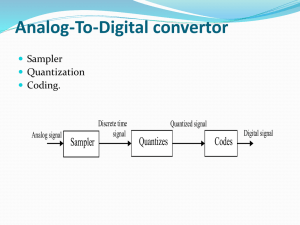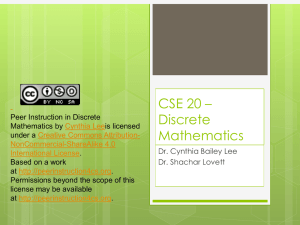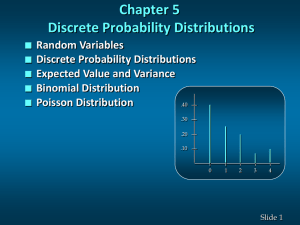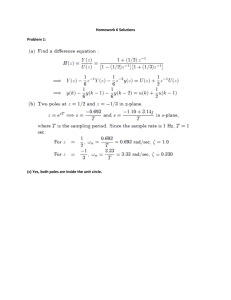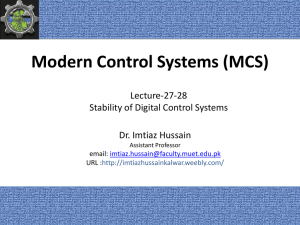DC_w11
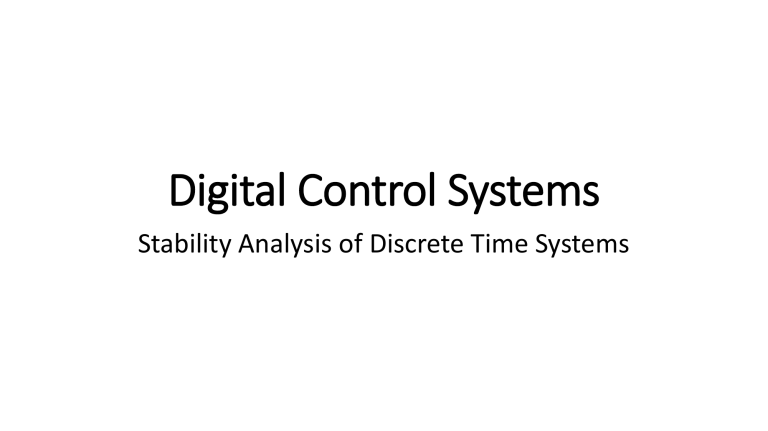
Digital Control Systems
Stability Analysis of Discrete Time Systems
Mapping Between the s-plane and the z-plane
Mapping Between the s-plane and the z-plane
Mapping Between the s-plane and the z-plane
Mapping Between the s-plane and the z-plane
Mapping Between the s-plane and the z-plane
Mapping Between the s-plane and the z-plane
Stability Analysis of Discrete Time Systems
BIBO Stability
An initially relaxed (all the initial conditions of the system are zero) LTI system is said to be
BIBO stable if for every bounded input, the output is also bounded.
However, the stability of the following closed loop system can be determined from the location of closed loop poles in z-plane which are the roots of the characteristic equation
Stability Analysis of Discrete Time Systems
BIBO Stability
1. For the system to be stable, the closed loop poles or the roots of the characteristic equation must lie within the unit circle in z-plane. Otherwise the system would be unstable.
2. If a simple pole lies at |z| = 1, the system becomes marginally stable. Similarly if a pair of complex conjugate poles lie on the |z| = 1 circle, the system is marginally stable.
Multiple poles on unit circle make the system unstable.
Stability Analysis of Discrete Time Systems
BIBO Stability
Example:
Determine the closed loop stability of the system shown in Figure when K = 1.
Stability Analysis of Discrete Time Systems
BIBO Stability
Example:
Stability Analysis of Discrete Time Systems
BIBO Stability
Stability Tests
Applied to characteristic equation
• Schur-Cohn stability test
• Jury Stability test
• Routh stability coupled with bi-linear transformation.
Applied to state space
• Lyapunov stability analysis
Stability Analysis of Discrete Time Systems
Jury Stability Test
Jury Table
Stability Analysis of Discrete Time Systems
Jury Stability Test
Jury Table
Stability Analysis of Discrete Time Systems
Jury Stability Test
Jury Table
The system will be stable if:
Stability Analysis of Discrete Time Systems
Jury Stability Test
Example:
Stability Analysis of Discrete Time Systems
Jury Stability Test
Example:
Stability Analysis of Discrete Time Systems
Jury Stability Test
Example:
Stability Analysis of Discrete Time Systems
Jury Stability Test
Example:
Stability Analysis of Discrete Time Systems
Jury Stability Test
Singular Cases
Stability Analysis of Discrete Time Systems
Jury Stability Test
Example:
Stability Analysis of Discrete Time Systems
Jury Stability Test
Example:
Stability Analysis of Discrete Time Systems
Bilinear Transformation
The bilinear transformation has the following form.
where a, b, c, d are real constants. If we consider a = b = c = 1 and d = −1, then the transformation takes a form
This transformation maps the inside of the unit circle in the z-plane into the left half of the w-plane
Stability Analysis of Discrete Time Systems
Bilinear Transformation
Let the inside of the unit circle in z-plane can be represented by:
Stability Analysis of Discrete Time Systems
Bilinear Transformation
Let the inside of the unit circle in z-plane can be represented by:
Stability Analysis of Discrete Time Systems
Routh Stability Criterion
Stability Analysis of Discrete Time Systems
Routh Stability Criterion
𝑄(𝑤) = 𝑎
0 𝑤 𝑛
+ 𝑎
1 𝑤 𝑛−1
+ ⋯ + 𝑎 𝑛−1 𝑤 + 𝑎 𝑛 𝑤 𝑛 𝑤 𝑛−1 𝑤 𝑛−2 𝑤 𝑛−3 𝑤 𝑛−4 𝑤
⋮
2 𝑤 1 𝑤 0 𝑎
0 𝑎
1 𝑎
2 𝑎
3 𝑏
1 𝑐
1 𝑑
1 𝑑
⋮ ⋮
2 𝑒 𝑓
1
1 𝑒
2 𝑔
0 𝑏
2 𝑐
2 𝑎
4 𝑎
5 𝑏
3 𝑐
3 𝑑
3 𝑎
6 𝑎
7 𝑏
4 𝑐
4 𝑑
4
⋯ a i i ⋯
⋯
⋯
⋯
Necessary and sufficient condition for all roots of Q(w) to be located in the left-half plane is that all the 𝑎 𝑖 are positive and all of the coefficients in the first column be positive.
Stability Analysis of Discrete Time Systems
Routh Stability Criterion
Example:
There is one sign change in the first column of the
Routh array. Thus the system is unstable with one pole at right hand side of the w-plane or outside the unit circle of z-plane.
Stability Analysis of Discrete Time Systems
Routh Stability Criterion
Example:
All elements in the first column of Routh array are positive.
Thus the system is stable.
Stability Analysis of Discrete Time Systems
Routh Stability Criterion
Example:
Find out the range of K for which the system is stable.
Stability Analysis of Discrete Time Systems
Routh Stability Criterion
Example:
Stability Analysis of Discrete Time Systems
Routh Stability Criterion
Example:
Stability Analysis of Discrete Time Systems
Routh Stability Criterion
Singular cases
• The first element in any row is zero→replace zero by a small number and then proceed with the tabulation.
• All the elements in a single row are zero o Pairs of real roots with opposite signs.
o Pairs of imaginary roots.
o Pairs of complex conjugate roots which are equidistant from the origin.
→ an auxiliary equation A (w)
0 is formed by using the coefficients of the row just above the row of all zeros. The tabulation is continued by replacing the row of zeros by the coefficients of dA (w) dw


